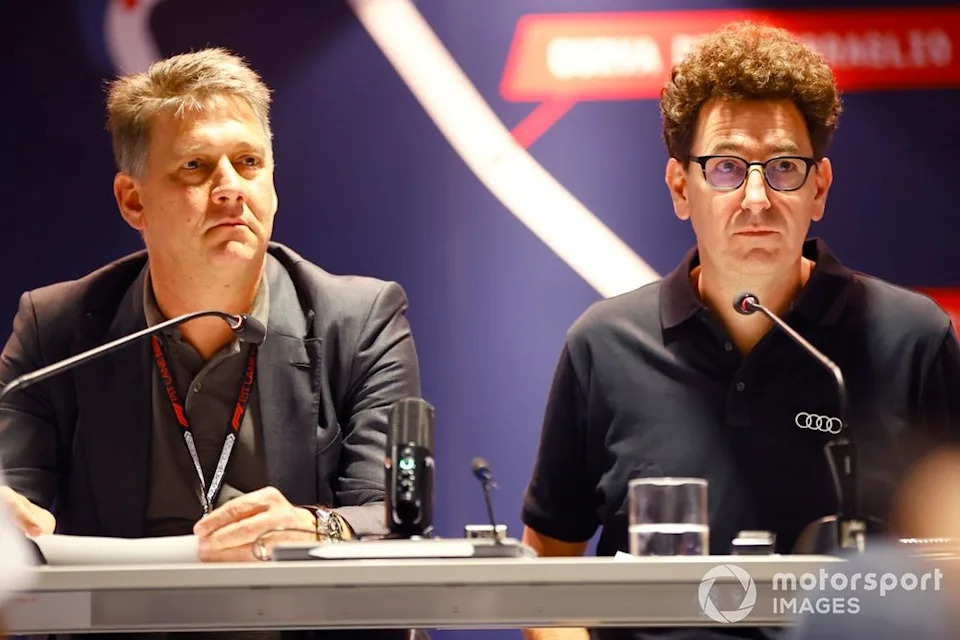When Method 1 adopted turbocharged hybrid energy models for the 2014 season, one producer ÔÇô ÔÇô had been ploughing assets into its undertaking longer and extra intensively than anybody else. The end result was virtually 5 seasons of complete dominance whereas rivals struggled to catch up ÔÇô and within the case of Renault, you can argue it by no means did.
The thought that the forthcoming shift to new energy models with extra electrical deployment could possibly be a case of 2014 another time is what retains a number of staff principals up at night time.
Commercial
This background angst has been buzzing via F1ÔÇÖs mechanism for months and proof of its results are throughout: initially of the season and are simply two examples. Most lately, in one more administration restructure at Audi ÔÇô like London buses, wait lengthy sufficient and a number of other will come alongside virtually directly ÔÇô engine chief Adam Baker has been given the heave-ho.
AudiÔÇÖs F1 engine programme is about up as a separate firm, albeit as a totally owned subsidiary of Audi Sport. Baker ÔÇô who spent over a decade being concerned in racing powertrains at BMW, and was at Cosworth earlier than that ÔÇô had been in control of F1 engine improvement at Audi SportÔÇÖs ÔÇśCompetence Centre MotorsportÔÇÖ (it reads extra elegantly within the authentic German as a usually Teutonic collision of nouns) in Neuburg an der Donau for the reason that summer season of 2022.
This newest bout of administration musical chairs comes on the heels of phrase circulating that the Audi engine programme is in hassle, and firm CEO Gernot Dollner turning up in individual to what was described as a ÔÇścrunch assemblyÔÇÖ between F1 stakeholders forward of the Bahrain Grand Prix.
ItÔÇÖs understood that DollnerÔÇÖs was as soon as of the voices arguing strongly for better catch-up provisions to be enshrined inside the 2026 guidelines. Most others had been in settlement ÔÇô Mercedes, believed to be within the strongest place in the intervening time, much less so ÔÇô and this was one of many publicised outcomes.
Commercial
The problem goes to return in threading such a mechanism via F1ÔÇÖs present monetary restrictions.
Audi CEO Gernot Dollner and Mattia Binotto, CEO and CTO, Stake F1 Workforce KICK Sauber
Audi CEO Gernot Dollner and Mattia Binotto, CEO and CTO, Stake F1 Workforce KICK SauberAndy Hone / Motorsport Photographs
Andy Hone / Motorsport Photographs
ÔÇťThere have been imbalances up to now,ÔÇŁ FIA single-seater director Nikolas Tombazis advised Motorsport.com, ÔÇťand usually such issues get overcome with further spending by individuals who have to get better, in addition to with a lot exhausting work, sweat and tears.
ÔÇťThat’s tougher with the associated fee cap. There are already provisions within the laws for underperformers ÔÇô these had been put in as a placeholder again in 2022 when the laws had been first accredited. We at the moment are within the strategy of discussing with the PU producers what the precise provisions have to be for that.
Commercial
ÔÇťSimply to be clear, we’re discussing provisions that will allow an under-performer to hold out extra improvement work. We’re categorically not discussing any synthetic mechanism that will increase the efficiency of an underperforming engine.
ÔÇťThat is vital below the associated fee cap, as a result of [otherwise] we could possibly be going through a scenario the place an underperformer would by no means be capable of catch up below the associated fee cap.
ÔÇťThere’s a large quantity of know-how in F1. WeÔÇÖre asking folks [i.e. new PU manufacturers] to leap into the deep finish once they donÔÇÖt have this accrued know-how over 10 or 15 years, so we really feel that morally and from a equity standpoint there have to be a mechanism which permits them to catch up and compete on the identical degree.
ÔÇťWe donÔÇÖt need to have anyone whoÔÇÖs eternally condemned to distress and humiliation.ÔÇŁ
Commercial
The case research right here is Honda ÔÇô which, regardless of a wealthy historical past in F1 and wider motorsport, failed dismally in its first efforts to create a aggressive hybrid PU. Getting on par with the likes of Mercedes and took years, included a divorce from after three seasons collectively, and sucked in huge portions of economic and engineering useful resource ÔÇô to the extent that touring automobile programmes, as an illustration, had their budgets slashed.
Fernando Alonso, McLaren MP4-30 Honda
Fernando Alonso, McLaren MP4-30 HondaGlenn Dunbar / Motorsport Photographs
Glenn Dunbar / Motorsport Photographs
Having reached the head, Honda determined sufficient was sufficient and introduced its withdrawal from F1 once more, solely to U-turn on that call as its partnership with Purple Bull blossomed into a number of championship wins and the better electrification of the 2026 guidelines package deal proved sufficiently aligned with its road-car enterprise.
Commercial
ÔÇťHonda is an extremely gifted organisation with very succesful folks, and fortuitously they’d the resilience and stamina and engineering functionality to push via,ÔÇŁ mentioned Tombazis. ÔÇťIf they’d not been in a position to spend a bit more cash throughout that interval, perhaps they might not have managed to catch up. We wish new PU producers to remain for the lengthy haul.ÔÇŁ
At a gathering of the F1 Fee on the Thursday after the Saudi Arabian Grand Prix all of the events , however the specifics needed to be booted up the highway. ThatÔÇÖs partly as a result of there was a wider and considerably extra urgent dialogue round the opportunity of altering the combo {of electrical} deployment throughout races, to deal with the fears of automobiles operating out of vitality on lengthy straights.
Concepts for the catch-up mechanism had been handed on to a separate energy unit working group, which can formulate extra detailed proposals. Motorsport.com understands that the more than likely final result of this will probably be a sliding scale of dyno testing and engine funds cap concessions, relying on the dimensions of efficiency and/or reliability disparities.
This may be roughly analogous to the present regime governing aerodynamic testing, the place groups on the prime of the constructorsÔÇÖ championship face better constraints on wind tunnel and CFD analysis than these on the backside.
Commercial
The problem is now the element, and the way to keep away from loopholes. Whereas simplification and cost-cutting had been central to the philosophy of the 2026 engine package deal, as soon as aggressive intuition kicks in it’s tough to not spend.
F1 2026 FIA automobile renders
F1 2026 FIA automobile rendersFIA
FIA
As an illustration, pistons within the present technology of PUs are made from high-grade metal in extremely advanced geometries. Given the mechanical and thermal stresses on this space, the producers already in F1 have constructed up a wealth of experience and understanding ÔÇô the ÔÇťknow-howÔÇŁ to which Tombazis alludes. A single piston prices within the area of $10,000 to fabricate.
Commercial
It is understood that the brand new producers fascinated by becoming a member of F1 when the 2026 laws had been first mentioned ÔÇô together with Porsche ÔÇô pushed exhausting for aluminium to be adopted as a substitute, solely to reverse out of that place as soon as they’d juggled the figures required and noticed alternatives the place benefits could possibly be gained.
Learn Additionally:
The end result has been an inevitable dilution of the cost-cutting drive.
ÔÇťBecause the FIA we’re the moderators throughout the dialogue of the laws, aware to comprise prices and create a degree enjoying area for all,ÔÇŁ mentioned Tombazis. ÔÇťThere may be some sturdy resistance at occasions, as you’ll anticipate, from groups or PU Producers defending their pursuits or funding.
ÔÇťValue-cutting and degree of technological freedom are at loggerheads with one another. It isn’t straightforward to have each.ÔÇŁ
To learn extra Motorsport.com articles .













